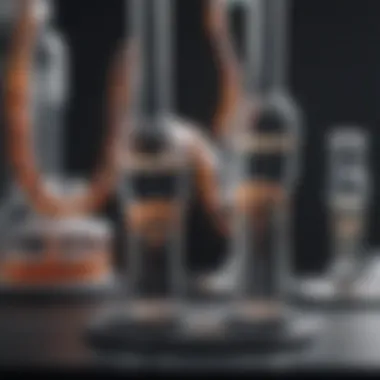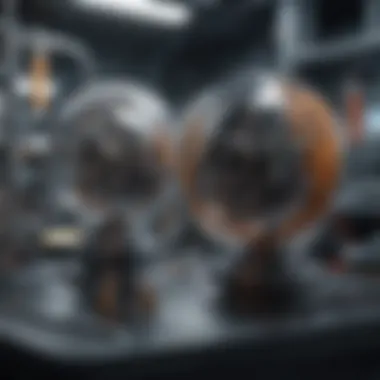Exploring Dual Systems in Biotechnology


Intro
The realm of biotechnology is undergoing a significant transformation, propelled by innovative approaches that merge various systems to enhance efficiency and promote sustainability. One of the key concepts emerging from this transformation is the idea of dual systems. These frameworks function by integrating two distinct yet complementary processes to optimize biotechnological outcomes. This concept has garnered attention across multiple disciplines, revealing its potential not only for improving productivity but also for addressing pressing global challenges such as food security and environmental sustainability.
A comprehensive exploration of dual systems requires a nuanced understanding of their underlying mechanisms and applications. This overview aims to illuminate the importance of dual systems in biotechnology, shedding light on their technical foundations and ethical considerations while engaging with current trends and methodologies in the field. By examining the complexities involved, the narrative seeks to provide readers with insights that are crucial for both academic research and practical applications.
Prolusion to Dual Systems in Biotechnology
The study of dual systems in biotechnology presents a fascinating area of exploration that integrates biological components with technological frameworks. Understanding these systems is essential as they hold the potential to significantly enhance biotechnological processes. Dual systems leverage the strengths of different biological pathways or organisms, creating a platform for innovation in various fields such as agriculture, pharmaceuticals, and environmental science. By providing a unique approach, dual systems can improve efficiency, sustainability, and productivity.
Defining Dual Systems
Dual systems can be defined as frameworks that utilize two distinct biological functions or organisms to achieve specific goals. These systems often combine different metabolic pathways or involve interconnected biological networks. This integration allows for the optimization of resource usage, improved product yield, and increased adaptability to changing environmental conditions.
Historical Context and Development
The concept of dual systems in biotechnology is not entirely new. Historically, researchers have explored various biotechnological methods that tap into the synergistic effects of multiple biological components. From early genetic engineering efforts to the development of recombinant DNA technology, the trend has gradually evolved toward integrating more complex biological interactions. With advancements in synthetic biology, this field has gained momentum, leading to the establishment of sophisticated dual systems that are now being implemented in real-world scenarios.
Relevance in Modern Biotechnology
In contemporary biotechnological practices, the importance of dual systems cannot be overstated. They are particularly valuable in enhancing the efficiency of metabolic engineering, facilitating the production of valuable compounds. Such systems also play a critical role in addressing challenges associated with sustainability, especially in the face of global issues like climate change and population growth. By fostering a more resilient biotechnological framework, dual systems can contribute to meeting future demands in food production, healthcare, and environmental management.
"Dual systems are at the forefront of innovation, enabling biotechnologists to push the boundaries of what is possible in various applications."
In summary, the introduction of dual systems in biotechnology is an area worthy of significant attention. Their capacity to combine diverse biological functions has implications that extend beyond mere efficiency. They potentially redefine processes, contributing to a more sustainable future in biotechnology.
The Mechanisms of Dual Systems
The mechanisms of dual systems in biotechnology are essential for understanding how these systems operate and interact within various biotechnological applications. The integration of diverse technological and biological frameworks enhances efficiency and productivity. Moreover, dual systems highlight the synergy between different biological components, enabling researchers to address complex problems in agriculture, pharmaceuticals, and environmental protection. Therefore, a comprehensive exploration of these mechanisms is crucial for realizing the full potential and versatility of dual systems in contemporary biotechnology.
Technical Framework
The technical framework of dual systems outlines the essential components and processes that allow these systems to function effectively. It involves the combination of various technologies such as synthetic biology, genetic engineering, and advanced computational methods. These technologies work together, forming a solid foundation for dual systems. For example, the incorporation of bioreactors and sensor technology ensures real-time monitoring and control of bioprocesses.
Key features of the technical framework include:
- Robust data management systems
- High-throughput screening techniques
- Integration of machine learning for predictive analytics
These aspects enable researchers to optimize conditions for biological processes, ultimately leading to increased production yields and sustainability.
Integration of Biological Components
Integration of biological components within dual systems is fundamental for achieving desired outcomes. This process entails the incorporation of diverse organisms or biological pathways to foster cooperation. For instance, a dual system may combine microbial strains with distinct functionalities, such as degradation of waste products and production of valuable metabolites.
Several considerations arise during this integration:
- Compatibility of metabolic pathways
- Genetic stability of the combined organisms
- Effective communication between biological components


By addressing these factors, researchers can enhance the overall functionality of dual systems, which significantly contributes to advancements in fields like bioremediation and biofuel production.
Systems Biology Perspective
Viewing dual systems from a systems biology perspective provides a comprehensive understanding of their operation and dynamics. Systems biology emphasizes the interactions between biological components and how these relationships influence system behavior. This approach allows for a holistic view of complex biological systems, promoting deeper insights into dual systems.
The systems biology perspective involves:
- Modeling biological interactions
- Analyzing signal transduction pathways
- Assessing the effects of environmental factors on system performance
By adopting this perspective, researchers are equipped to evaluate the potential benefits and drawbacks of dual systems, ultimately fostering more reliable and sustainable biotechnological applications.
The integration of advanced technologies and biological components within dual systems enables unprecedented innovation in biotechnology.
Applications of Dual Systems
Understanding the applications of dual systems in biotechnology is central to grasping their multifaceted impact on modern science and industry. Dual systems utilize the synergy between biological and technological frameworks to drive innovation across various sectors. Their importance lies not only in enhancing efficiency but also in addressing complex challenges within biotechnology.
Pharmaceutical Development
In the field of pharmaceutical development, dual systems play a crucial role in drug discovery and production. For instance, the combination of mammalian cell cultures and microbial systems allows for the rapid development of biopharmaceuticals. Dual systems enable the optimization of protein expression and modification, which is essential for creating therapeutics that meet stringent safety and efficacy standards. Through these systems, researchers can test hypotheses faster and iterate on drug formulations without the need for traditional lengthy processes.
Moreover, dual systems facilitate the screening of large compound libraries. This improves the identification of lead candidates significantly, offering substantial economic benefits. By integrating high-throughput methodologies with advanced cellular models, researchers can significantly shorten the lead time from concept to market. This trend demonstrates the dual systems' capacity to streamline pharmaceutical workflows, reduce costs, and enhance overall innovation in drug development.
Agricultural Biotechnology
Agricultural biotechnology relies heavily on dual systems for developing sustainable practices and enhancing crop yields. The integration of genetically modified organisms (GMOs) with traditional breeding practices empowers scientists to improve the resilience and productivity of various crops. For instance, combining biotech traits such as pest resistance with conventional resistance breeding can lead to plants that are more robust against environmental stressors.
Additionally, dual systems allow for the development of biopesticides and biofertilizers. These biological agents can work alongside chemical alternatives to create a sustainable agricultural ecosystem. The use of dual systems contributes to reducing chemical inputs, fostering soil health, and maintaining biodiversity in farming systems. As agricultural demands rise, these innovations are vital for ensuring food security worldwide.
Environmental Biotechnology
In the realm of environmental biotechnology, dual systems present solutions for waste management and bioremediation processes. Their application addresses the pressing need to manage pollutants and hazardous materials effectively. For example, using microbial consortia—where diverse microbial populations work together—enhances the degradation of complex organic substances in contaminated environments. This collaborative approach can be more efficient than relying on a single species.
Furthermore, dual systems can aid in carbon capture and conversion technologies. By uniting engineered microbial systems with chemical processes, researchers are developing methods to convert carbon emissions into useful products. This synergy can lead to applications in biofuels production and carbon-neutral technologies, showcasing the potential of dual systems in creating a more sustainable future.
In summary, the application of dual systems across pharmaceutical development, agricultural biotechnology, and environmental biotechnology demonstrates their adaptability and importance. Their capacity to enhance processes and technologies positions them as indispensable tools for addressing contemporary challenges in biotechnology.
Comparative Analysis of Dual Systems
Understanding the comparative analysis of dual systems in biotechnology is crucial for grasping the evolving landscape of biotechnological applications. This section aims to highlight the core differences and advantages of dual systems over single systems. By dissecting the key components, one can better appreciate how dual systems offer enhanced versatility and potential for innovation.
Single vs. Dual Systems
Single systems in biotechnology often rely on a singular approach, which may limit their effectiveness in diverse applications. In contrast, dual systems integrate two distinctive biological platforms, allowing researchers to harness the strengths of both. This combination can lead to more robust responses to challenges such as disease resistance and environmental adaptation.
- Flexibility: Dual systems can adapt to different operational conditions more readily than their single counterparts. This flexibility can enable more targeted interventions according to specific needs.
- Synergy: By employing two systems, there is potential for mutual enhancement. For instance, one system can compensate for weaknesses in another, resulting in improved overall function.


Efficiency Metrics
Efficiency in biotechnology is paramount. Dual systems tend to exhibit increased efficiency through various metrics. These metrics assess production rates, resource consumption, and waste output.
- Resource Utilization: Dual systems often allow for optimized use of raw materials. Efficient conversion processes can significantly reduce input costs and environmental footprints.
- Scalability: The performance of dual systems can be more easily scaled to larger projects. This scalability is often linked to modular designs, making it simpler to expand operations.
Impact on Production Yield
The production yield is a pivotal measure of success in biotechnology. Dual systems typically achieve higher yields compared to single systems, thanks to their integrated approach.
- Enhanced Output: By combining multiple biological systems, dual setups can realize improved outputs, whether in pharmaceuticals or agricultural products.
- Risk Mitigation: The resilience provided by dual systems ensures consistent production levels even when one component faces challenges or failures. This reliability is essential in maintaining supply chains and meeting market demands.
In summary, a comparative analysis of dual systems offers invaluable insights into their benefits over single systems. Recognizing these differences can inform future biotechnological advancements and guide the development of new applications.
Challenges in Implementing Dual Systems
Implementing dual systems in biotechnology presents considerable challenges, each impacting their efficiency and viability. Understanding these challenges enables stakeholders to make informed decisions on the development and utilization of these systems. The significant barriers include technical difficulties, economic factors, and regulatory compliance, all of which play crucial roles in determining the success of dual systems in various applications.
Technical Barriers
The technical barriers in dual systems often revolve around the integration of distinct biological components. Merging different systems requires a robust framework for ensuring compatibility and efficiency. Many times, the biological parts involve organisms or systems that have been optimized separately, which complicates their interplay.
Moreover, issues regarding the scalability of processes can arise. Techniques that work on a small scale may not function the same way when scaled up. This poses hurdles in moving from laboratory settings to practical applications in industries like pharmaceuticals or agriculture. Not only that but optimizing conditions such as pH, temperature, and nutrient availability becomes more complex with dual system setups.
Economic Considerations
From an economic standpoint, the investment required to develop and implement dual systems can be substantial. Financial commitments in technology and infrastructure are needed typically before seeing any return. Organizations must analyze the cost-benefit ratio to ensure that the advantages of dual systems outweigh the initial outlay.
Additionally, ongoing operational costs can be higher due to the necessity for specialized equipment and technical expertise. The market for biotechnology is competitive; therefore, if dual systems do not provide a clear economic advantage, organizations may hesitate to pursue these avenues.
Regulatory Hurdles
Lastly, regulatory hurdles impose significant challenges on the adoption of dual systems in biotechnology. Regulatory bodies require comprehensive assessments of safety, efficacy, and environmental impact before approving new technologies.
Navigating this regulatory landscape is complex as it often varies by country or region. Different jurisdictions may have distinct requirements that necessitate extensive documentation and testing. The lengthy approval processes can further delay the introduction of dual systems into practical applications, deterring potential investors or stakeholders.
Understanding the challenges in adopting dual systems could significantly enhance their development and integration into various biotechnological fields.
Addressing these barriers is crucial for advancing dual systems. Through targeted research, economic analysis, and advocacy for streamlined regulations, the full potential of dual systems can be realized, enabling significant advancements in biotechnology.
Ethical Implications of Dual Systems
The exploration of ethical implications surrounding dual systems in biotechnology is vital for the responsible advancement of this field. Ethical considerations often shape public perception, regulatory frameworks, and ultimately the success of biotechnological processes. Addressing these implications is crucial for fostering a deeper understanding of how dual systems can be developed and utilized in an ethically sound manner.
Bioethics and Public Perception
Public perception plays a significant role in shaping the regulations and acceptance of biotechnological innovations. Bioethical debates often arise regarding the use of dual systems, particularly in relation to genetic modifications and synthetic biology. Stakeholders, ranging from researchers to policy-makers, must engage with ethical issues, addressing concerns that may arise in communities.


It is essential to establish trust with the public through transparent discussions about the potential benefits and risks associated with dual systems. For instance, the introduction of genetically modified organisms (GMOs) through dual systems can trigger fears about food safety and environmental impact. Therefore, it is critical to have informed public discourse that encompasses these ethical dilemmas, thus guiding research and applications toward sustainable practices.
"Engagement with the public on bioethical issues is not just a regulatory obligation, but a moral imperative in biotechnology."
Long-term Effects on Biodiversity
The long-term impact of dual systems on biodiversity necessitates careful ethical consideration. Utilizing dual systems can enhance productivity and sustainability in biotechnology, but it may also lead to unintended ecological consequences. The introduction of engineered organisms into natural ecosystems can disrupt local biodiversity, leading to potential harm to native species and habitats.
It is important to evaluate how dual systems interact with existing ecosystems. Ethical implications arise when evaluating trade-offs between enhanced agricultural yields and the preservation of natural diversity. Research must address these concerns proactively, considering the delicate balance between innovation and environmental integrity.
Future Perspectives on Dual Systems Biotechnology
The future of dual systems in biotechnology holds significant promise. This concept not only enhances productivity but also contributes to sustainable practices in various fields. As we delve into this topic, it is essential to recognize the multifaceted nature of dual systems, which serves as a crucial framework for innovation in biotechnology. Looking ahead, we explore several key areas of development that are likely to shape the upcoming landscape.
Innovative Research Directions
Research is at the forefront of biotechnological advancements. Some possible directions include:
- Synthetic Biology: Harnessing dual systems can lead to sophisticated synthetic pathways, helping create custom organisms with desirable traits. This could revolutionize how we approach genetic engineering.
- Metabolic Engineering: By manipulating pathways, scientists can optimize production for pharmaceuticals and biofuels. Innovative research here may address efficiency gaps observed in current methods.
- Systems Biology Approaches: Integrating dual systems with systems biology could lead to enhanced predictive models. This capacity might allow researchers to forecast cellular responses under various conditions more accurately.
These directions emphasize the necessity for sustained investment in research. They also highlight the collaborative effort among multidisciplinary teams to explore uncharted territories in dual system applications.
Technological Advancements
Emerging technologies will play a pivotal role in the evolution of dual systems. Some significant advancements that may occur include:
- CRISPR Technology: This gene-editing tool can facilitate targeted modifications in dual systems, leading to more precise and effective genetic changes.
- High-Throughput Screening: Innovations in automation and analytics can streamline the identification of suitable candidates for dual system applications in various biotechnological processes.
- Bioinformatics Tools: Enhanced data analysis capabilities can optimize the integration of biological components, driving efficiency and innovation. Researchers can gain deeper insights into the interactions involved within dual systems.
These advancements emphasize the importance of technology in shaping the dual systems landscape. The integration of cutting-edge tools will likely determine how quickly these systems can transition from laboratory research to real-world applications.
Potential Market Impact
The implications of dual systems extend beyond scientific advancements into economic realms. Important factors to consider include:
- Commercial Viability: As dual systems prove their worth in productivity, industries may increasingly adopt them, creating new markets focused on enhanced biotechnological solutions.
- Sustainability Incentives: Governments and organizations prioritize sustainable practices. Implementing dual systems could align with such goals, perhaps leading to financial incentives and support for developing these technologies.
- Global Health Solutions: The contributions of dual systems to drug discovery and environmental monitoring can impact public health positively. Their role in providing accessible and efficient solutions could reshape healthcare markets.
The potential market impact of dual systems encapsulates a broader trend towards sustainable development across industries. As stakeholders recognize their value, continued growth in this sector is likely.
Overall, the future perspectives of dual systems in biotechnology illuminate a promising path forward. Through innovative research, technological advancements, and market opportunities, the field continues to evolve. The depth and complexity of dual systems underscore their relevance in shaping future biotechnological practices.
End
The conclusion serves as a pivotal element in this discussion, as it encapsulates the intricate details explored throughout the article. In the realm of dual systems in biotechnology, this section synthesizes findings and highlights the significance of understanding systems' dynamics.
Summary of Key Findings
The examination of dual systems reveals several crucial insights. First, they enhance productivity across multiple biotechnological processes. This is largely due to their ability to integrate biological components effectively. Second, such systems play a vital role in various applications, from pharmaceuticals to environmental management. For instance, in pharmaceutical development, dual systems can streamline production and improve drug efficacy. Finally, the analysis underscores numerous challenges, such as technical barriers and regulatory issues, that must be addressed to maximize benefits.
Implications for Future Biotechnological Practices
The insights gained from this overview have substantial implications for future practices in biotechnology. As the field continues to evolve, integrating dual systems can lead to more sustainable solutions. Increasing productivity while minimizing ecological footprints is no longer an option but a necessity. The potential for advancements in this space is immense, especially with ongoing research into innovative techniques and technologies. Hence, understanding their implementation can guide researchers and practitioners in shaping the future landscape of biotechnology.
"A nuanced understanding of dual systems not only enhances current practices but also paves the way for future innovations."
As we move forward, the importance of addressing ethical considerations and public perception cannot be understated. This will ensure that advancements benefit society collectively, maintaining a balance between innovation and responsibility.



